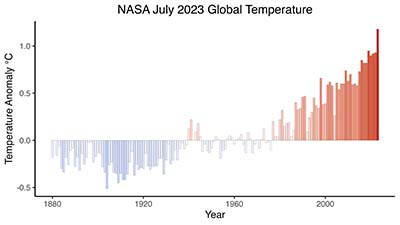According to scientists at NASA’s Goddard Institute for Space Studies (GISS) in New York, July 2023 was hotter than any other month in the global temperature record.
Overall, July 2023 was 0,24 degrees Celsius (C) warmer than any other July in NASA’s record, and it was 1,18C warmer than the average July between 1951 and 1980.
The primary focus of the GISS analysis are long-term temperature changes over many decades and centuries, and a fixed base period yields anomalies that are consistent over time. Temperature “normals” are defined by several decades or more – typically 30 years.
“NASA data confirms what billions around the world literally felt: temperatures in July 2023 made it the hottest month on record,” said NASA administrator Bill Nelson. “The science is clear. We must act now to protect our communities and planet; it’s the only one we have.”

This chart shows global temperature anomalies for every July since the 1880s, based on NASA’s GISTEMP analysis. Anomalies reflect how much the global temperature was above or below the 1951-1980 norm for July.
Credits: NASA’s Goddard Institute for Space Studies
Parts of South America, North Africa, North America, and the Antarctic Peninsula were especially hot, experiencing temperatures increases around 4C above average. Overall, extreme heat this summer put tens of millions of people under heat warnings and was linked to hundreds of heat-related illnesses and deaths.
The record-breaking July continues a long-term trend of human-driven warming driven primarily by greenhouse gas emissions that has become evident over the past four decades. According to NASA data, the five hottest Julys since 1880 have all happened in the past five years.
“Climate change is impacting people and ecosystems around the world, and we expect many of these impacts to escalate with continued warming,” says Katherine Calvin, chief scientist and senior climate advisor at NASA headquarters. “Our agency observes climate change, its impacts, and its drivers, like greenhouse gases, and we are committed providing this information to help people plan for the future.”
NASA assembles its temperature record from surface air temperature data from tens of thousands of metrological stations, as well as sea surface temperature data acquired by ship- and buoy-based instruments. This raw data is analysed using methods that account for the varied spacing of temperature stations around the globe and for urban heating effects that could skew the calculations.
“This July was not just warmer than any previous July – it was the warmest month in our record, which goes back to 1880,” says GISS director Gavin Schmidt. “The science is clear this isn’t normal. Alarming warming around the world is driven primarily by human-caused greenhouse gas emissions. And that rise in average temperatures is fueling dangerous extreme heat that people are experiencing here at home and worldwide.”
High sea surface temperatures contributed to July’s record warmth. NASA’s analysis shows especially warm ocean temperatures in the eastern tropical Pacific, evidence of the El Niño that began developing in May 2023.
Phenomena such as El Niño or La Niña, which warm or cool the tropical Pacific Ocean, can contribute a small amount of year-to-year variability in global temperatures. But these contributions are not typically felt when El Niño starts developing in Northern Hemisphere summer. NASA expects to see the biggest impacts of El Niño in February, March, and April 2024.
Featured picture: The map shows global temperature anomalies for July 2023 according to the GISTEMP analysis by scientists at NASA’s Goddard Institute for Space Studies. Temperature anomalies reflect how July 2023 compared to the average July temperature from 1951-1980.
Credits: NASA’s Goddard Institute for Space Studies

